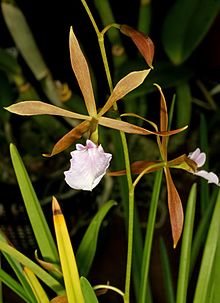Encyclia
| Encyclia | ||||||||||||
|---|---|---|---|---|---|---|---|---|---|---|---|---|

Encyclia diurna |
||||||||||||
| Systematics | ||||||||||||
|
||||||||||||
| Scientific name | ||||||||||||
| Encyclia | ||||||||||||
| Hook. |
The genus Encyclia from the family of the orchid (Orchidaceae) comprises about 120 plant species , which occur in South and Central America. These are perennial , epiphytic or lithophytic plants.
description
The species of the genus Encyclia grow sympodially , the pseudobulbs stand at short intervals on a creeping rhizome . The roots emerge from the rhizome and are surrounded by a four to eight cell layer thick velamen . The pseudobulbs, which consist of an internode , are round, egg-shaped to cigar-shaped. At its tip there are usually two, more rarely only one or up to four leaves . The leaves are lanceolate and folded along the midrib, leathery to fleshy, rarely with an almost round leaf cross-section.
The mostly paniculate , sometimes racemose , rarely single-flowered inflorescence appears without a flower sheath at the tip of the shoot. The fragrant flowers are resupinated . The color of the sepals and petals is often greenish-brown, more rarely pink to purple. The inner petals are shaped similarly to the outer three. The lip is mostly white or light pink, with dark pink colored veins. The lip is three-lobed, the side lobes are bent upwards and enclose the column . A usually two-row callus extends from the base of the lip to the middle lobe. The lip is free or only fused with the column at the base. This is club-shaped, often winged at the tip - these lip appendages grip the lip at the narrow point between the lateral and middle lobes. The stamen sits at the end of the column and contains four equally large pollinia .
The capsule fruit is spindle-shaped and round in cross-section.
The pollinating insects have not yet been observed, but from the shape of the flower it is concluded that these attract bees without offering nectar.
The known chromosome numbers are 2n = 40.
Distribution and locations
The species of the genus Encyclia are native to almost the entire Neotropic . The northernmost occurrences are in Mexico, all of Central America and the Caribbean are settled, to the south the area extends to southern Brazil, Paraguay and Argentina.
Most species are epiphytes of seasonally dry forests, others are found in ever-humid forests, and some have adapted to almost desert-like conditions. These orchids often grow in sunny, exposed locations, on the branches of deciduous trees or on rocks.
Systematics
Within the subfamily Epidendroideae , the genus Encyclia is classified in the tribe Epidendreae and there in the subtribe Laeliinae . Encyclia is closely related to Alamania , Artorima and Prosthechea .
A list of the recognized species can be found in R. Govaerts.
Botanical history
Joseph Dalton Hooker described the genus in 1828 with the type species Encyclia viridiflora - of which, however, no specimen has been found since then. The name of the genus means in ancient Greek εγκύκλιος egkyclios "forming a circle" and refers to the side lobes of the lip that encircle the column.
While John Lindley saw this genus only as a group within Epidendrum , it was separated again by Rudolf Schlechter . The demarcation from the closely related genus Prosthechea has long been unclear. The species known today as Prosthechea were previously all assigned to Encyclia , then separated as a separate genus and later renamed Epithecia , Anacheilium and Hormidium . Recent studies consider the two genera Encyclia and Prosthechea to be different. Species that used to be called the Encyclia Section Euchile are now part of Prosthechea or treated as an independent genus.
A number of smaller genera have been removed from the previously broader genus Encyclia . The genus Psychilis was already described by Rafinesque in 1838 , but the 15 known species were listed under Encyclia until 1988 . Similarly, the genus Dinema has existed since 1831, but the species have long been assigned to Encyclia . Artorima was split off in 1971 to contain the species Artorima erubescens , Hagsatera with two species was set up in 1974. Oestlundia was established in 2001 and comprises four species from Encyclia .
literature
- Alec M. Pridgeon, Phillip Cribb, Mark W. Chase: Genera Orchidacearum . Vol. 4/1: Epidendroidae (Part one) . Oxford University Press, 2005. pp. 232-236. ISBN 0-19-850712-7
- Carl L. Withner : The cattleyas and their relatives. Vol. 4: The Bahamian and Caribbean Species. Timber Press, Portland 1988. pp. 35-80. ISBN 0-88192-344-3
- Carl L. Withner: The cattleyas and their relatives. Vol. 5: Brassavola, Encyclia and Other Genera of México and Central America. Timber Press, Portland 1998. pp. 85-136. ISBN 0-88192-456-3
Individual evidence
- ↑ a b c Wesley E. Higgins, Cássio van den Berg, W. Mark Whitten: A Combined Molecular Phylogeny of Encyclia (Orchidaceae) and Relationships within laeliinae . In: Selbyana 24 (2): 165-179. 2003. Online, accessed on January 23, 2008 ( page no longer available , search in web archives ) Info: The link was automatically marked as defective. Please check the link according to the instructions and then remove this notice.
- ^ Cássio van den Berg, Mark W. Chase (2004): A reappraisal of Laeliinae: Taxonomic history, phylogeny and new generic alliances. Orchid Digest 4: 2004 221–225 ( PDF ( Memento of the original from September 26, 2007 in the Internet Archive ) Info: The archive link has been inserted automatically and has not yet been checked. Please check the original and archive link according to the instructions and then remove this note. )
- ↑ Rafaël Govaerts (Ed.): Encyclia. In: World Checklist of Selected Plant Families (WCSP) - The Board of Trustees of the Royal Botanic Gardens, Kew . Retrieved July 10, 2018.
- ↑ In: William Curtis (Ed.): Botanical Magazine . Vol. 55, p. 2831.
- ↑ Helmut Genaust: Etymological dictionary of botanical plant names. 3rd, completely revised and expanded edition. Nikol, Hamburg 2005, ISBN 3-937872-16-7 (reprint from 1996).






